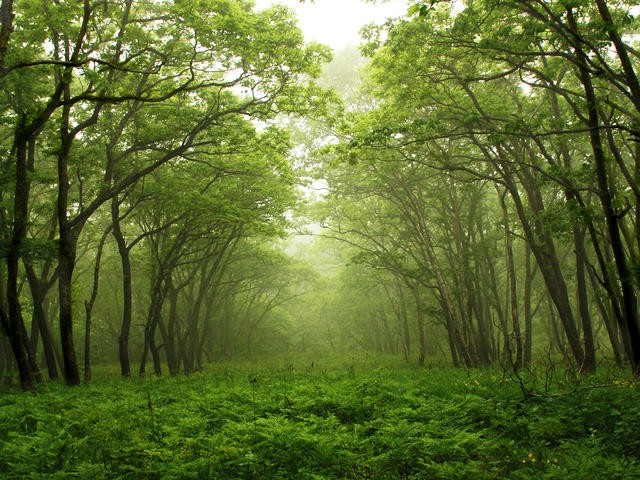forests
FORESTS COVER approximately 27 percent of the ice-free surface of the Earth, 13 million square mi or 34 million square km. The world's forests mainly occur in two broad zones: one centered in the tropical regions, the other in the Northern Hemisphere between 32 degrees N and 45 degrees N latitude. Globally, forest composition and distribution are influenced by precipitation and temperature. Soil, landform, and historical factors (for example, glaciation, natural and human disturbance) influence forest structure and composition on a local scale. Forests are generally absent from areas of low or strongly seasonal precipitation, including dry zones at the west side of continents and interior continental regions where annual precipitation is less than .29 in (.75 cm). The 50 degrees F (10 degrees C) isotherm marks the limit of tree growth in the Northern Hemisphere.
Forests can be classified into major types by LATITUDE, by amount and seasonal distribution of precipitation, or by macroclimate. Three forest types are recognized by latitude: tropical, temperate, and boreal forests. Tropical forests occur in the region bounded by the TROPIC OF CANCER and the TROPIC OF CAPRICORN, where frost is absent and rainfall is abundant but sometimes seasonal. Plants typical of tropical forests, like palms, generally do not occur beyond the 64 degree F (18 degrees C) isotherm. Temperate forests occur at mid-latitudes with warm summers and cool winters. Important temperate forest areas include eastern North America, Central and West Europe, and Northeast Asia. Smaller areas of temperate forest occur in CHILE and ARGENTINA, Southeast AUSTRALIA, and NEW ZEALAND. Boreal forests are restricted to the Northern Hemisphere and generally occur between 50 to 60 degrees N. Extreme winter temperatures, some exceeding -86 degrees F (-30 degrees C), select for cold-tolerant conifer species.

Forests can be further classified by their physical appearance (physiognomy) based on tree architecture and growth form or by the composition of their dominant species—floristics. Physiognomic classification is often applied at large scales (biomes, ecological regions) while floristic classification is typically applied at local scales. Forests can be grouped based on leaf characteristics into broad-leaved or needle-leaved forest and by leaf phenology (whether leaves are shed seasonally or retained) into deciduous or evergreen forest. Since leaf characteristics are influenced by climate, especially the seasonality of temperature and precipitation, modern classification systems join macroclimatic information and physiognomy to identify forest types.
Two macroclimate domains (groups of ecological regions with similar climate) support forests: the tropical and temperate domains. Tropical domain forest types include tropical and subtropical evergreen broadleaf forest, tropical and subtropical broadleaf deciduous forest, and mangrove forest. Tropical evergreen forests—RAINFORESTS—usually occur between the equator and 10 degrees N latitude, where rainfall is heavy and average annual temperatures approach 80 degrees F (27 degrees C). These forests are multilayered, with numerous vertical vegetation strata, and are composed of species with little cold or drought tolerance. Several types of tropical evergreen forest are recognized including lowland forest (trees greater than 98 ft or 30 m tall, sparse undergrowth, and abundant epiphytes); montane forest (trees less than 98 ft or 30 m tall, an undergrowth of tree ferns, and a rich ground layer of herbs and mosses); and cloud forest (gnarled tree canopy less than 98 ft or 30 m tall, many lianas and epiphytes, and a rich ground layer of mosses, herbs, and ferns). Tropical deciduous forests, in which canopy trees shed their leaves during the dry season, occur where rainfall is seasonal. Mangrove forests grow in tropical and subtropical intertidal zones and are composed of evergreen, salt-tolerant trees less than 98 ft or 30 m tall.
Temperate domain forests include both temperate and boreal elements and are of three types: broadleaved deciduous forest (leaf fall occurs in autumn and trees are dormant in winter); needle-leaved evergreen forest dominated by conifers; and broad-leaved evergreen forest. Broad-leaved deciduous forest of the northern temperate zone is dominated by oak (Quercus), maple (Acer), beech (Fagus), ash (Fraxinus), and lime or basswood (Tilia). Broad-leaved deciduous forest of the Southern Hemisphere (Patagonia, AUSTRALIA, Tasmania, and New Zealand) is often dominated by southern beech (Nothofagus). Needle-leaved evergreen forest occurs in a broad circumpolar belt in the Northern Hemisphere and in temperate montane areas like North America's Pacific Northwest. Dominant tree species include spruce, fir, and pine. Temperate broadleaved evergreen forest, the Valdivian and Magellanic rainforests, occurs on the western ANDES' wet slopes. Evergreen southern beeches are common in the canopy; trees may exceed 164 ft or 50 m in height.
Today, virtually all the world's forests are under pressure from a burgeoning human population that consumes land, fuel, and forest products at a rapid rate. Globally, a balance between forest protection and development must be struck to ensure that the ECOSYSTEM services that forests provide will continue to benefit life on Earth.